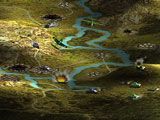 At
this moment, in the early fall of 1999, computer wargaming is yet again on
the ropes. Rarely does a major publishing company deign to produce a
serious wargame, and even such grognard favorites as Talonsoft and SSI
have increasingly turned to greener pastures. If you want a hardcore
wargame, you just about have to search the web for small independents like
HPS. But wargaming has endured dark hours before, and none darker than
those months before the release of SSI’s original Panzer General, a
beer-and-pretzels wargame that against all odds became a smash mainstream
hit. It also introduced a whole new generation to the joys of wargaming,
producing--at least in part--the audience for games like Steel Panthers
and the Battleground series. Will the release of SSI’s latest in the
Panzer General Series, Panzer General 3D Assault, be able to work the same
mojo on the flat wargames market? Well, it’s a tough call, but given
that PG3D combines the simple-yet-addictive gameplay of the original with
flashy 3D acceleration and conventions subtly lifted from role-playing
games, it’s got a chance.
At
this moment, in the early fall of 1999, computer wargaming is yet again on
the ropes. Rarely does a major publishing company deign to produce a
serious wargame, and even such grognard favorites as Talonsoft and SSI
have increasingly turned to greener pastures. If you want a hardcore
wargame, you just about have to search the web for small independents like
HPS. But wargaming has endured dark hours before, and none darker than
those months before the release of SSI’s original Panzer General, a
beer-and-pretzels wargame that against all odds became a smash mainstream
hit. It also introduced a whole new generation to the joys of wargaming,
producing--at least in part--the audience for games like Steel Panthers
and the Battleground series. Will the release of SSI’s latest in the
Panzer General Series, Panzer General 3D Assault, be able to work the same
mojo on the flat wargames market? Well, it’s a tough call, but given
that PG3D combines the simple-yet-addictive gameplay of the original with
flashy 3D acceleration and conventions subtly lifted from role-playing
games, it’s got a chance.
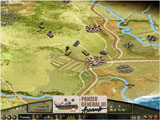 First, let me put
out the grognard alert: PG3D ain’t for those that demand hyper-realism,
or even semi-hyper-realism, from their wargames. While the game system is
more nuanced and complex than the previous Panzer Generals, it’s still
built upon their simple-yet-sturdy engine. If you found those games too
slack for your refined tastes, PG3D won’t convert you. The game’s
scale is still weirdly indeterminate and flexible from scenario to
scenario, and your units might be about division- or
regiment-sized--though it’s clear that exact army TO&Es were of no
concern whatsoever to the game’s designers. If you’re the kind who can’t
play a game because someone left an understrength recon battalion’s HQ
company out of the counter mix, PG3D will just cause you to hemorrhage.
And nobody wants that. However, for those ‘nards who don’t mind the
occasional "beer and pretzels" game that emphasizes fun and
playability over realism, PG3D is a very worthwhile diversion.
First, let me put
out the grognard alert: PG3D ain’t for those that demand hyper-realism,
or even semi-hyper-realism, from their wargames. While the game system is
more nuanced and complex than the previous Panzer Generals, it’s still
built upon their simple-yet-sturdy engine. If you found those games too
slack for your refined tastes, PG3D won’t convert you. The game’s
scale is still weirdly indeterminate and flexible from scenario to
scenario, and your units might be about division- or
regiment-sized--though it’s clear that exact army TO&Es were of no
concern whatsoever to the game’s designers. If you’re the kind who can’t
play a game because someone left an understrength recon battalion’s HQ
company out of the counter mix, PG3D will just cause you to hemorrhage.
And nobody wants that. However, for those ‘nards who don’t mind the
occasional "beer and pretzels" game that emphasizes fun and
playability over realism, PG3D is a very worthwhile diversion.
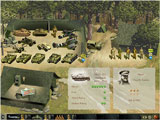 The most
noticeable change from the previous Panzer Generals is right there in the
game’s title. It’s 3D, baby. It’s the wave of the future. Gone are
the gorgeous hand-painted maps of Panzer General 2, now replaced by 3D
landscapes that you’re either gonna love or hate. Myself, I’ve got
mixed feelings about the graphics. While I groove on the fact that the
maps can be zoomed and rotated, and while I’m impressed by the
nicely-delineated hills and valleys, the maps seem just a little too
brilliant and gaudy for me. A little more grittiness would have gone a
long way. Cities are unfortunately very generic, and it can be very
difficult to see units located in them. On the other hand, unit graphics
are terrific. They look like microarmor miniatures, and are nicely
detailed—it’s easy to differentiate a Matilda from a Crusader. Even
better are the unit animations. As tanks roll across the desert, they’ll
kick up clouds of dust; attacking engineers shoot out plumes of fire from
their flamethrowers; destroyed planes descend in flaming spirals and
explode in spectacular balls of flame. And some of these gratuitously
glorious graphics even aid in gameplay. When a unit takes damage, it will
begin to smoke; if it takes a bit more, it will smoke even more, and
heavily damaged units will cook up like bonfires. This allows you to
assess the state of your own and enemy units very quickly, and is an
extremely useful touch.
The most
noticeable change from the previous Panzer Generals is right there in the
game’s title. It’s 3D, baby. It’s the wave of the future. Gone are
the gorgeous hand-painted maps of Panzer General 2, now replaced by 3D
landscapes that you’re either gonna love or hate. Myself, I’ve got
mixed feelings about the graphics. While I groove on the fact that the
maps can be zoomed and rotated, and while I’m impressed by the
nicely-delineated hills and valleys, the maps seem just a little too
brilliant and gaudy for me. A little more grittiness would have gone a
long way. Cities are unfortunately very generic, and it can be very
difficult to see units located in them. On the other hand, unit graphics
are terrific. They look like microarmor miniatures, and are nicely
detailed—it’s easy to differentiate a Matilda from a Crusader. Even
better are the unit animations. As tanks roll across the desert, they’ll
kick up clouds of dust; attacking engineers shoot out plumes of fire from
their flamethrowers; destroyed planes descend in flaming spirals and
explode in spectacular balls of flame. And some of these gratuitously
glorious graphics even aid in gameplay. When a unit takes damage, it will
begin to smoke; if it takes a bit more, it will smoke even more, and
heavily damaged units will cook up like bonfires. This allows you to
assess the state of your own and enemy units very quickly, and is an
extremely useful touch.
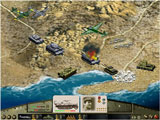 But 3D graphics
aren’t the only non-traditional addition to PG3D; gameplay has been made
much more interesting by the addition of an action-based movement and
combat system, as well as an almost RPG-like emphasis on leader
development. In PG3D, you’ll begin a scenario by selecting leaders from
your leader pool. Since you have a limited number of slots for these
leaders, you must choose wisely. Each leader belongs to a certain branch
of the army—infantry, armor, AAA, arty, air, etc., and after choosing
them you’ll assign them to specific units. Again, (and unlike the
previous PGs) you’ll have a limited number of these, so you can’t
compose an army entirely of King Tigers, for instance. Obviously, it’s a
good idea to have leaders command units from their own branch of the
sevice, though you could, if you were perverse enough, assign an
anti-aircraft leader to lead your paratroopers. Once your units have seen
combat, they’ll begin to gain experience, and as their experience
increases, so will their efficiency—they’ll be able to take more
actions per turn. But they’ll also gain random special abilities,
according to their branch. This adds a welcome role-playing aspect to the
game, and judicious use of special abilities makes an enormous difference
in the game and adds a layer of depth that just wasn’t in the earlier
games. But beware: you can’t assemble a massive army made up of nothing
but elite commanders—the more experienced a leader becomes, the more
deployment slots he takes up. You’ll have to choose between a small but
elite army, a large rabble, or a more balanced force. Sounds easy, but you’ll
very often be forced to reluctantly leave one of your experienced veterans
on the bench in favor of some much-needed fodder.
But 3D graphics
aren’t the only non-traditional addition to PG3D; gameplay has been made
much more interesting by the addition of an action-based movement and
combat system, as well as an almost RPG-like emphasis on leader
development. In PG3D, you’ll begin a scenario by selecting leaders from
your leader pool. Since you have a limited number of slots for these
leaders, you must choose wisely. Each leader belongs to a certain branch
of the army—infantry, armor, AAA, arty, air, etc., and after choosing
them you’ll assign them to specific units. Again, (and unlike the
previous PGs) you’ll have a limited number of these, so you can’t
compose an army entirely of King Tigers, for instance. Obviously, it’s a
good idea to have leaders command units from their own branch of the
sevice, though you could, if you were perverse enough, assign an
anti-aircraft leader to lead your paratroopers. Once your units have seen
combat, they’ll begin to gain experience, and as their experience
increases, so will their efficiency—they’ll be able to take more
actions per turn. But they’ll also gain random special abilities,
according to their branch. This adds a welcome role-playing aspect to the
game, and judicious use of special abilities makes an enormous difference
in the game and adds a layer of depth that just wasn’t in the earlier
games. But beware: you can’t assemble a massive army made up of nothing
but elite commanders—the more experienced a leader becomes, the more
deployment slots he takes up. You’ll have to choose between a small but
elite army, a large rabble, or a more balanced force. Sounds easy, but you’ll
very often be forced to reluctantly leave one of your experienced veterans
on the bench in favor of some much-needed fodder.
Other than that, the game plays much like the earlier Panzer Generals.
The AI, while not brilliant, is more than competent, and I was rudely
surprised more than once by clever and well-timed counterattacks. The AI
seems especially good at picking vulnerable targets. This is particularly
the case with enemy air units, which are at times superbly handled and
always a royal pain. And while the interface takes some getting acquainted
with, I eventually found it streamlined and easy to use.
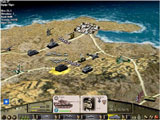 PG3D comes with
eight campaigns, and they’re the meat of the game. The campaigns focus
on World War II in the West, so you can forget seeing any T-34s in this
game (though an East Front version of PG 3D is rumored to be in the
works). There are four major campaigns of a little less than 20 scenarios
each that pretty much run the entire course of the WWII in the West, and
four smaller ones of a little more than five scenarios each that explore
lesser-known campaigns. I’m particularly fond of these smaller, somewhat
eccentric campaigns—I mean, how many computer games have focused on O’Connor’s
romp against the Italians in Cyrenacia? Or allow you to replay the
invasion of Southern France? Or let you take command of Free French forces
and liberate Paris? PG3D’s aforementioned emphasis on developing leaders
really drew me into the campaigns. It’s very rewarding to see your units
acquire experience and gradually evolve from levy status to hardened elite
forces.
PG3D comes with
eight campaigns, and they’re the meat of the game. The campaigns focus
on World War II in the West, so you can forget seeing any T-34s in this
game (though an East Front version of PG 3D is rumored to be in the
works). There are four major campaigns of a little less than 20 scenarios
each that pretty much run the entire course of the WWII in the West, and
four smaller ones of a little more than five scenarios each that explore
lesser-known campaigns. I’m particularly fond of these smaller, somewhat
eccentric campaigns—I mean, how many computer games have focused on O’Connor’s
romp against the Italians in Cyrenacia? Or allow you to replay the
invasion of Southern France? Or let you take command of Free French forces
and liberate Paris? PG3D’s aforementioned emphasis on developing leaders
really drew me into the campaigns. It’s very rewarding to see your units
acquire experience and gradually evolve from levy status to hardened elite
forces.
But for all the game’s strengths, it does have a few problems.
Foremost of these is that all the effort put into the campaigns seems to
have worked to the detriment of the single player stand-alone scenarios
and the game’s multiplayer functions. You can only play one side in each
of the stand-alone scenarios, and they seem peculiarly rigged for play
balance. For example, when I played the Germans in the Sealion scenario in
the Rommel campaign, I had to scrap hard against wave after wave of RAF
attacks. Eventually my own air forces were destroyed, and as I advanced
further inland, my lack of airpower became a serious handicap as Brit
bombers pretty much had their way. This seemed very historically
plausible, and I was impressed. But when I played the Sealion stand-alone
scenario as the Brits, I was only allowed to deploy just a few measly air
units. I have a feeling this was done for play balance reasons, which is
somewhat understandable, but still speaks to a certain carelessness in the
construction of the stand-alone scenarios.
More distressing is the lack of multiplayer options. You can play over
LAN, TCP/IP, or on Mplayer (which is unfortunately not currently
implemented). There’s no modem play. More damning is the lack of a play
by email option—something that SSI began omitting with its PGII-based
Rites of War. It’s not a happy decision.
There is also a bit of clumsiness surrounding the game’s maps. There
are no roll-over place names on the strategic map, and objectives aren’t
clearly marked on the tactical map. This makes for a lot of unnecessary
moving between maps just to make sure you’re attacking in the right
direction. A few other glitches with the maps include misspelled town
names, and some discrepancies between objectives given in your briefings
and those actually found on the map.
This is enough to keep the game from being awarded a five-star rating,
but not enough to stay me from enthusiastically recommending it. Panzer
General 3D Assault is a subtle yet marked improvement on the earlier
games. Whether it rescues computer wargaming from yet another of its
recurrent crises remains to be seen, but it’s a fun, fast-moving,
graphically ambitious and thoroughly enjoyable game in its own right. If
the rumored East Front version can iron out a few of the PG3D’s kinks,
we’re talking Hall of Fame, baby.
--Rick Fehrenbacher

 At
this moment, in the early fall of 1999, computer wargaming is yet again on
the ropes. Rarely does a major publishing company deign to produce a
serious wargame, and even such grognard favorites as Talonsoft and SSI
have increasingly turned to greener pastures. If you want a hardcore
wargame, you just about have to search the web for small independents like
HPS. But wargaming has endured dark hours before, and none darker than
those months before the release of SSI’s original Panzer General, a
beer-and-pretzels wargame that against all odds became a smash mainstream
hit. It also introduced a whole new generation to the joys of wargaming,
producing--at least in part--the audience for games like Steel Panthers
and the Battleground series. Will the release of SSI’s latest in the
Panzer General Series, Panzer General 3D Assault, be able to work the same
mojo on the flat wargames market? Well, it’s a tough call, but given
that PG3D combines the simple-yet-addictive gameplay of the original with
flashy 3D acceleration and conventions subtly lifted from role-playing
games, it’s got a chance.
At
this moment, in the early fall of 1999, computer wargaming is yet again on
the ropes. Rarely does a major publishing company deign to produce a
serious wargame, and even such grognard favorites as Talonsoft and SSI
have increasingly turned to greener pastures. If you want a hardcore
wargame, you just about have to search the web for small independents like
HPS. But wargaming has endured dark hours before, and none darker than
those months before the release of SSI’s original Panzer General, a
beer-and-pretzels wargame that against all odds became a smash mainstream
hit. It also introduced a whole new generation to the joys of wargaming,
producing--at least in part--the audience for games like Steel Panthers
and the Battleground series. Will the release of SSI’s latest in the
Panzer General Series, Panzer General 3D Assault, be able to work the same
mojo on the flat wargames market? Well, it’s a tough call, but given
that PG3D combines the simple-yet-addictive gameplay of the original with
flashy 3D acceleration and conventions subtly lifted from role-playing
games, it’s got a chance.